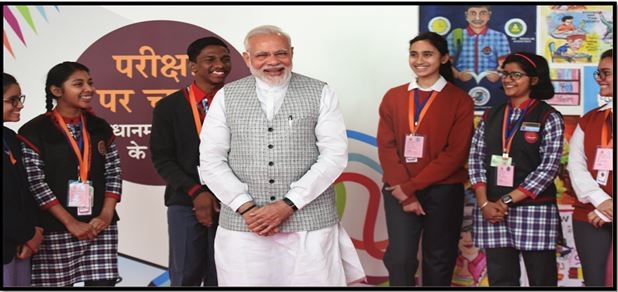National Education Day: Building a Brighter Tomorrow
Here are some major landmark initiatives, the Government of India has launched to build a robust education system that fosters holistic development of students, expand access to quality education and build a resilient learning environment
HYDERABAD: With a strong resolve to build strong education infrastructure that fosters holistic development of students and empowers the youth, the Government of India has launched a slew of initiatives.
Prime Minister Narendra Modi, on November 11 which was celebrated as the National Education Day marking the birth anniversary of Maulana Abul Kalam Azad, the first Education Minister of independent India and a prominent educationist, observed that with 65% of the nation’s population under the age of 35, it is crucial to provide them with opportunities for quality education and skills development, the Ministry of Education said in a statement.
“We want to develop an education system so that the youth of our country don’t need to go abroad. Our middle-class families need not spend lakhs and crores of rupees. Not only that, we also want to create such institutions that attract people from abroad to come to Bharat instead,” he said.
The following are some key policy initiatives launched by the Government of India to promote access to education.
Education, a fundamental right: The free primary education, reinforced by the 86th Amendment of the Constitution through Article 21-A, guarantees free and compulsory education for children aged six to fourteen as a fundamental right.
Rights to Education (RTE) Act, 2009: The Act ensures that every child receives quality elementary education in a formal school. These legal frameworks, backed by government schemes and initiatives, reflect India’s commitment to building an inclusive and equitable educational system for all.
NEP 2020: The Union Cabinet of India approved the National Education Policy (NEP) 2020 on July 29, 2020. The NEP seeks to overhaul India’s education system to better align with the needs of the 21st century, fostering a more inclusive and forward-thinking approach.
PM SHRI: Launched on September 7, 2022, the scheme aims to strengthen over 14,500 schools across India and foster quality education, cognitive development, and 21st-century skills in students. With a total project cost of ₹27,360 crore, it is being implemented over five years (2022-2027), with a central share of ₹18,128 crore.
Samagra Shiksha: Aligned with the NEP 2020 recommendations, Samagra Shiksha aims to provide quality education with an inclusive and equitable classroom environment for all children, addressing their diverse backgrounds and needs. Launched on April 1, 2021, it focuses on fostering active participation and enhancing academic abilities across various student groups.
PRERNA: Launched as a pilot phase from January 15, 2024, to February 17, 2024, in Gujarat, the initiative is a week-long residential programme designed for selected students from class IX to XII. It aims to offer an experiential and inspirational learning experience, blending heritage with innovation through state-of-the-art technology.
ULLAS: Also known as Nav Bharat Saaksharta Karyakram (New India Literacy Programme – NILP), ULLAS was launched to empower adults aged 15 and above, especially those who missed out on formal schooling.
NIPUN Bharat: The National Initiative for Proficiency in Reading with Understanding and Numeracy (NIPUN Bharat) aims to ensure that every child in the country achieves foundational literacy and numeracy by the end of Grade 3, with a target completion by 2026-27.
Vidya Pravesh: The VIDYA PRAVESH aims to provide a warm and welcoming environment for children entering Grade-I, ensuring a smooth transition and fostering a positive learning experience.
Vidyanjali: The School Volunteer Management Programme aims to enhance the quality of education in schools by fostering community involvement, and encouraging contributions from corporate social responsibility (CSR) initiatives and the private sector.
DIKSHA: The platform aims to enhance teacher training and professional development by accelerating innovative solutions and experiments in education. It empowers states and Teacher Education Institutes (TEIs) with the flexibility to customise the platform to meet their specific needs.
SWAYAM Plus: Launched by Union Education Minister Dharmendra Pradhan on February 27, 2024, the initiative seeks to revolutionise higher education and improve employability by implementing an innovative credit recognition system for industry-relevant courses, emphasizing skill development, employability, and forging stronger industry partnerships.
NISHTHA: The NISHTHA (National Initiative for School Heads’ and Teachers’ Holistic Advancement), aims to enhance the professional development of 42 lakh elementary teachers and school heads. NISHTHA 2.0 was launched for secondary school teachers, while NISHTHA 3.0 focusses on Foundational Literacy and Numeracy.
NIRF Ranking: The National Institutional Ranking Framework (NIRF) introduced a structured and transparent system for assessing and ranking universities, colleges, and other institutions, fostering healthy competition and encouraging improvements in education and infrastructure.
PM-Vidyalaxmi scheme: The Union Cabinet has recently approved the PM-Vidyalaxmi scheme to support meritorious students by providing financial assistance for quality higher education. This scheme offers education loans for students admitted to the top 860 institutions across India, benefiting over 22 lakh students each year.
Investing for a brighter future: The Department of School Education & Literacy has been allocated a record ₹73,498 crore in the FY 2024-25 budget, with 19.56% increase over the Revised Estimate for FY 2023-24. In FY 2024-25, the Department of Higher Education saw a budget increase of ₹3,525.15 crore (7.99%) compared to FY 2023-24.
Increase in enrolment: The All India Survey on Higher Education (AISHE) 2021-2022 highlighted that female enrolment rose from 1.57 crore in 2014-15 to 2.07 crore in 2021-22, an increase of 32%. The dropout rate at the secondary level has also decreased significantly from 21% in 2013-14 to 13% in 2021-22.


Comments are closed.